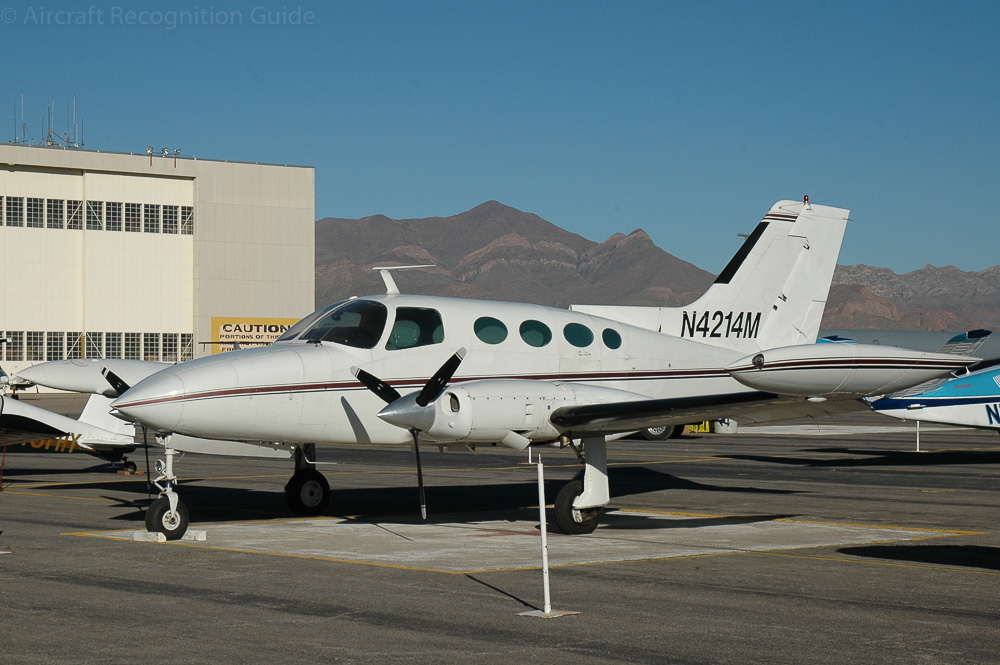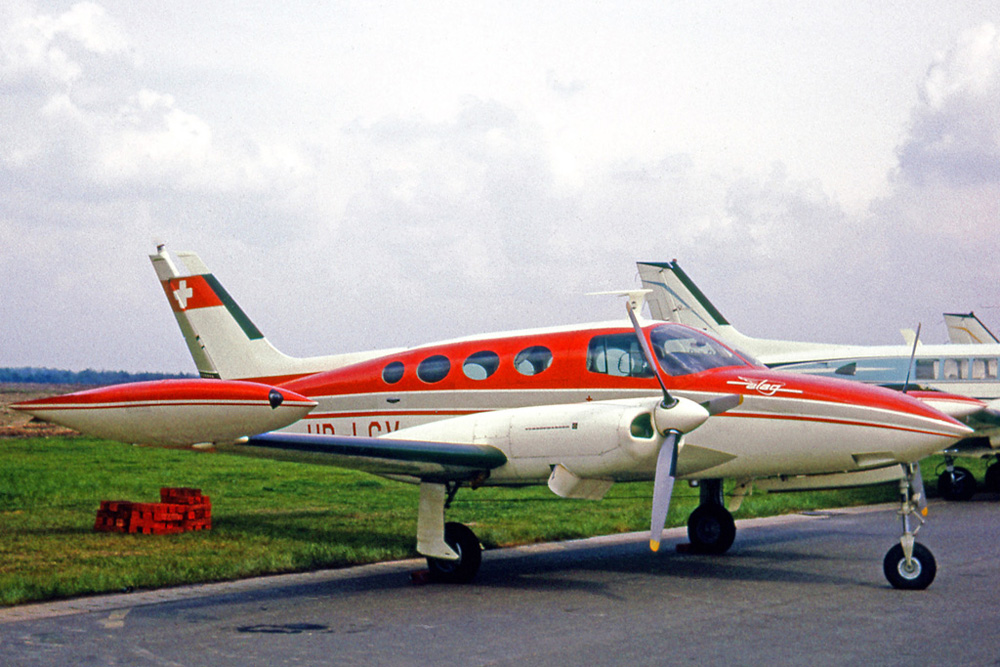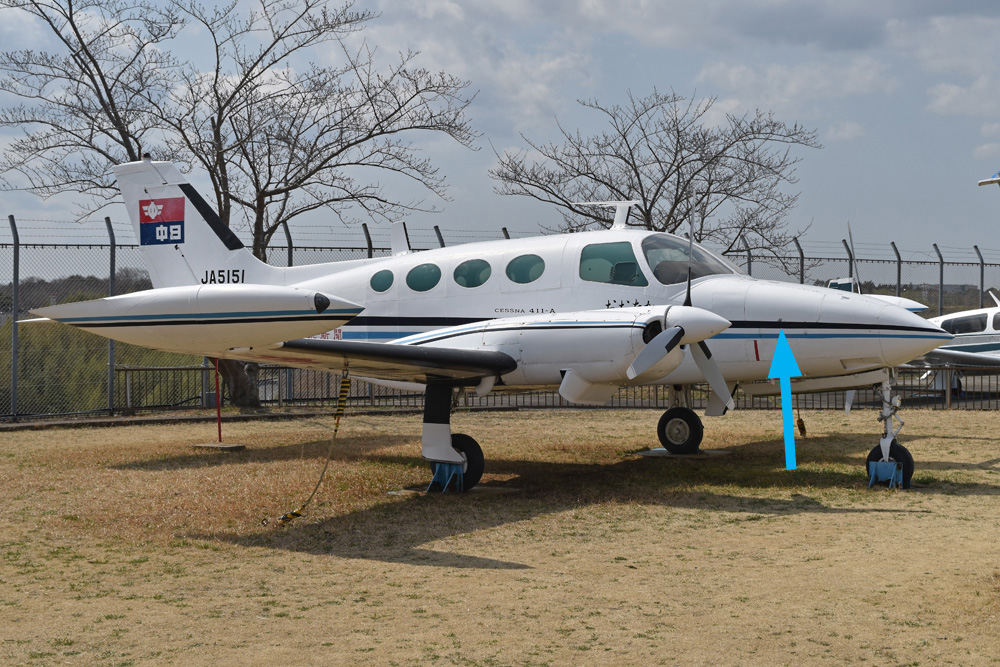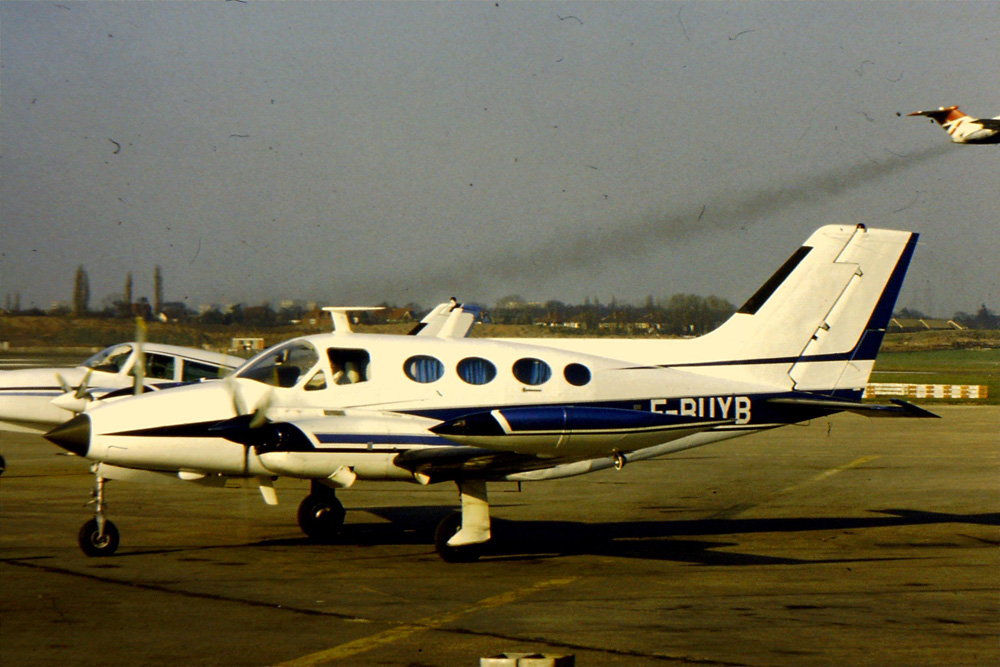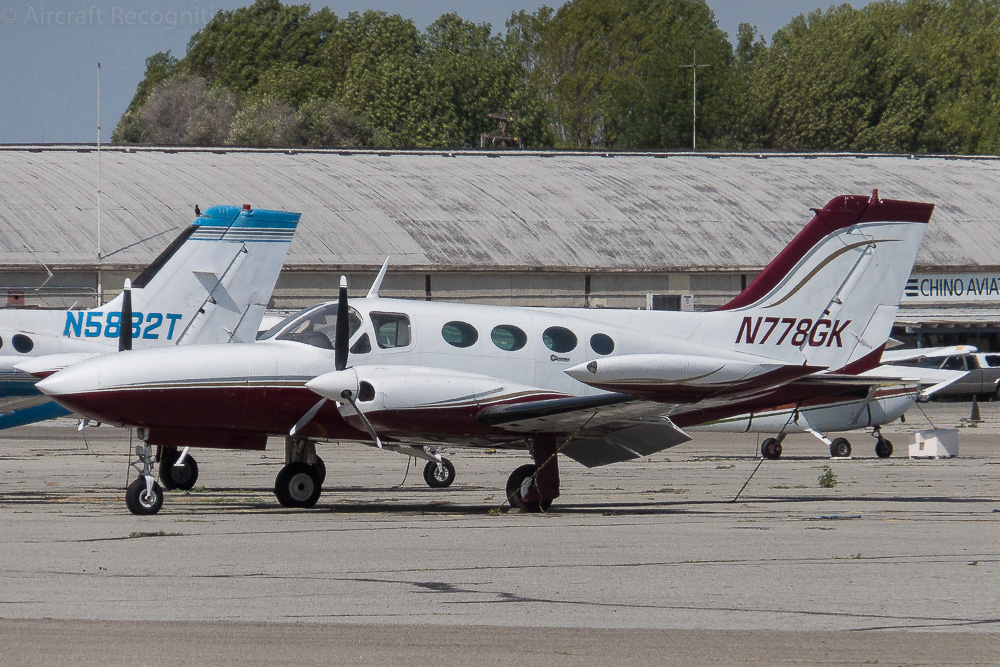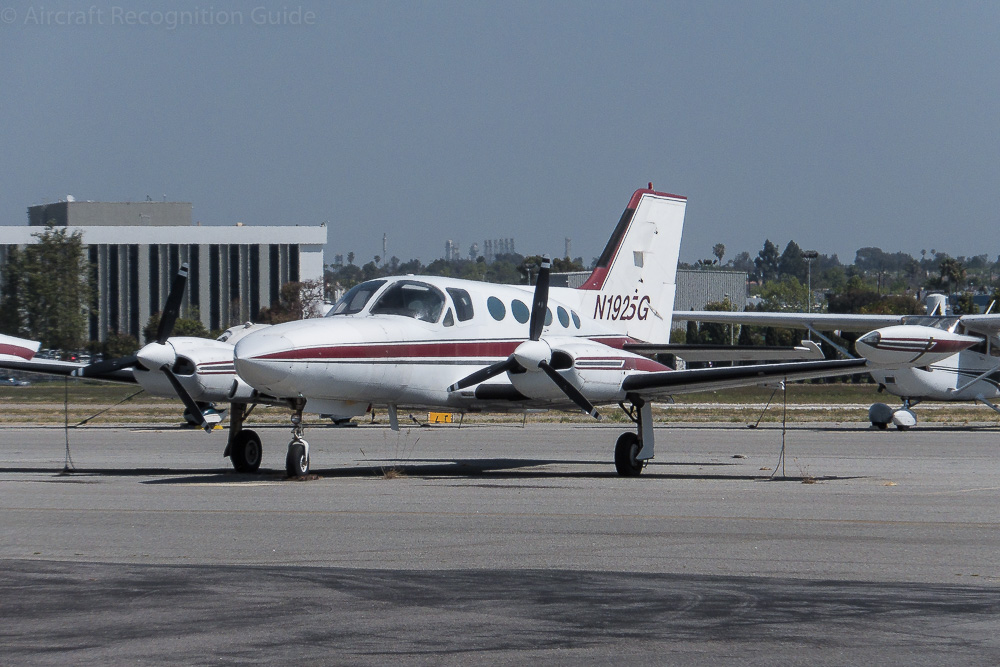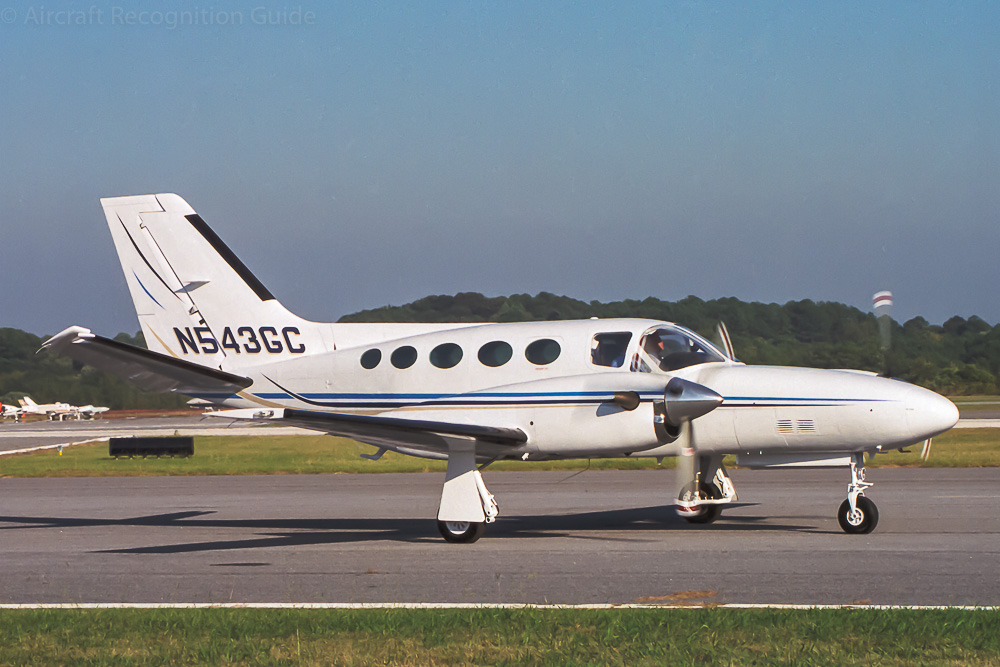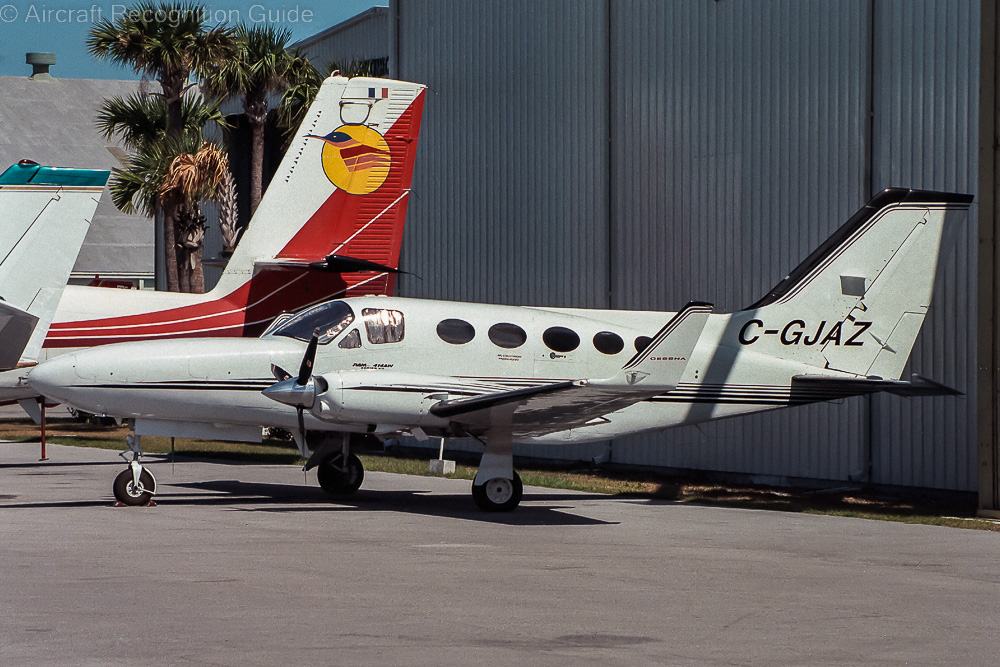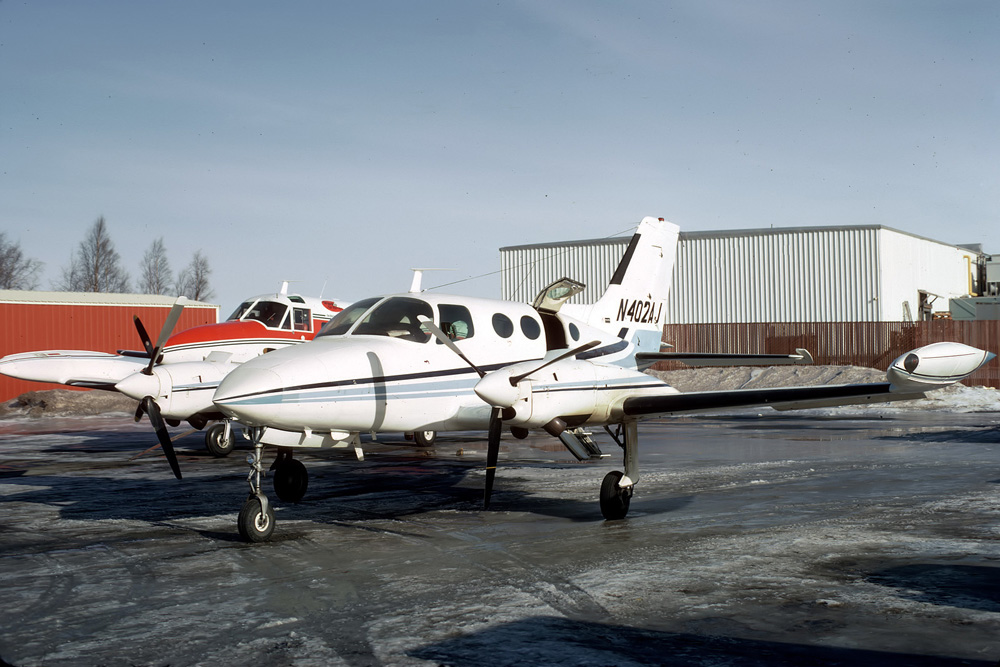
Cessna 401, 402, 411, 414, 421 & 425
During the beginning of the 1960s Beechcraft brought the first modern eight to ten seat twin prop plane on the market, the Queen Air. Cessna did not stay behind and started the 400 series, starting with the Cessna 411. All are low wing, low horizontal stabiliser aircraft, with two piston or turboprop engines in the wing's leading edge. The single wheel main landing gear retracts sidewards into the wings. Most versions have large oval cabin windows although later Cessna started using rectangular ones. These models are described on a separate page.
The cockpit windows are different for pressurised and non-pressurised model. The pressurised ones have a small triangular side window.
Here the non-pressurised cockpit windows and non-geared engines are shown in one photo. The drive shaft is in the middle of the nacelle. There is a small windows in the cockpit side window but without a frame.
Different versions
The different versions of the oval cabin window Cessna 400 series can be recognised by
- the shape and number of the cockpit windows
- the number of cabin windows
- the shape of the nose
- the shape of the engine nacelles
- the number of propeller blades
- the presence of tip tanks
- the presence of winglets
- the dihedral of the horizontal stabilisers
Cessna 401, 401A, 401B & 402
Model 401 was actually not the first of the family, but derived from the 411. The 401 is a non-pressurised aircraft, which can be noted from the cockpit side windows: they do not have a small triangular window in between the front and side window (see detail photo above). So there are four cockpit windows. The 401 has four oval cabin windows on each side, and an airstair door on the left side. A sidewards opening extra door is optional. The latter can be recognised by two hinge fairings.
Another feature of the 401 is the wide-chord vertical tail, which is about as wide as it is high. In front is a narrow dorsal fin with a tiny opening at the root. Finally, the Cessna 401 has tip tanks and non-geared engines. The drive shaft is more less centered in the nacelle when viewed from the side (see detail photo above).
Compared to the Cessna 401 model 401A has minor changes we could not spot on the outside. Similarly, the Cessna 401B also has some small improvements.
The Cessna 402 is externally the same as the 401. It has a reinforced bonded-honeycomb floor, for heavier duty use.
Cessna 402A & 402B
The main difference between the Cessna 402A and the original Cessna 402 is the lengthened nose, with a larger baggage compartment. Look for the larger distance between the nose cone and nose gear for distinction. A crew entry door, in the right cockpit side window, is optional.
In another upgrade the Cessna 402A became the 402B, which initially only minor changes. From the 1973 model on it has an increased cabin volume and five rectangular cabin windows on each side. This version is described separately.
The nose contour of the Cessna 402A has a different shape because it is longer than that of the Cessna 402.
Cessna 411
This was the ‘founding member’ of the Cessna 400 series. It is generally similar to the Cessna 401, regarding the cockpit windows, four cabin windows and tip tanks. Different though is the vertical stabiliser, which is fairly shallow: it is higher than it is tall. Additionally, the engines are geared, which means that the drive shaft lies slightly on top of the nacelle when viewed from the side, much like on the 421B/421C. The baggage compartment in the nose can only be accessed from the left side. It is immediately after the nose cone. On right side of the nose there are only panels to get access to systems.
Cessna 411A
This version is the same as the Cessna 411 but then with a redesigned nose to hold more baggage. The baggage door is placed further aft than on the 411, at about 80 cm from the nose, and at both sides. The length of the nose is the same though. Some examples have a less pointed, but unfortunately it does not apply to all 411As.
Cessna 414
Model 414 is a combination of two existing models: it has the pressurised fuselage of the Cessna 421 and the wings and engines of the Cessna 401B. The pressurisation capability can be noticed by the small triangular cockpit side window, the so-called storm window (see detail photo above). The engines are non geared, so the drive shaft is centered on the nacelle (see detail photo above). The first years the Cessna 414 had four cabin windows, but this increased to five windows from the 1973 model on.
Cessna 414A Chancellor
The Cessna 414A is similar in appearance to the Cessna 421C: five oval cabin windows, a long pointed nose, a higher vertical stabiliser and no tip tanks. However, the prop spinner (and drive shaft) is in the middle of the engine, typical for non-geared engines (see detail photo above).
The Cessna 414A has the fuselage, tail, gear and wings of the Cessna 421C (so no tip tanks), but non geared engines.
Cessna 421
The Cessna 411A was fitted with a pressurised cabin and also has the broader vertical tail like the 401/402. Like the 414 it has small triangular cockpit side windows, a feature of the pressurised cabin. Also the small intake at the root of the drosal fin is gone. The Cessna 421 equipped with geared engines (see detail photo above for characteristics).
The Cessna 421 has a short nose, a small triangular cockpit side window, geared engines and tip tanks. (photo G B_NZ/WikiMedia)
Cessna 421A
The Cessna 421A is three inches longer than the standard 421, but we failed to see this difference on the outside. Other differences are even more subtle.
The Cessna 421A is supposed to be three inches longer than the Cessna 421, but do you see the difference? (photo Peter Bakema/WikiMedia)
Cessna 421B
Although the wingspan has been increased compared to the 421A, and the engines have moved out as well, we doubt whether this is easily visible as it is only by 40cm. The nose was stretched two feet to accommodate a larger nose baggage section, so that is better visible. This version at first had four cabin windows, but later models (possibly from 1973 on) have five cabin windows.
Cessna 421C Golden Eagle
Remove the tip tanks from a late model 421B and make the vertical tail higher, and you get a 421C. At least from the outside. From the 1981 model is also has a trailing link main landing gear instead of a straight one. The main gear doors then also got a different shape.
The ultimate Cessna piston twin with oval cabin windows is the 421C Golden Eagle. It has clean wing tips and geared engines. Early models like this one have a straight main gear.
Later models Golden Eagle received a trailing link main gear. Note that the shape of the main gear door changed compared to the straight gear version.
Cessna 425 Corsair/Conquest I
From the outside the Cessna 425 at first looks like another Cessna 421C converted with turboprops driving three-bladed or four-bladed props. However, the horizontal stabilisers have a significant dihedral, whereas that of the older (converted) pistons is straight. The nose is somewhat more blunt as well.
Corsair was the name of the original version. A factory upgraded version with more cabin space and a higher maximum takeoff weight is called Conquest I.
Excalibur 421
This is a remanufactured Cessna 421C with Pratt & Whitney PT6A-135A turboprop engines, Garmin G600 avionics, winglets and different aircraft systems. It can be distinguished from other 421Cs with turboprops and winglets by its five bladed props. Only one seems to be partially converted before the project was put on hold.
The Excalibur 421 has five bladed props as main recognition point.
RAM/Cessna 414AW
The Cessna 414A modified by RAM Aircraft with winglets is called RAM/Cessna 414AW. Some also received a blunt nose.
Apart from the winglets the RAM/Cessna 414AW is the same as the standard Cessna 414A. This particular aircraft also has a blunt nose.
RAM/Cessna 421CW
RAM Aircraft offers a winglet modification for the Cessna 421C, after which they are called RAM/Cessna 421CW.
Riley Jet Prop 421 & Turbine Rocket 421 (R421BL/R421CL)
This is a conversion of Cessna 421B/Cs with two Lycoming LTP101 turboprop engines by Riley. These have "pitot style" air intakes below the spinners, slightly separated from the spinner. The single exhaust is at the end of the nacelle, behind the wing's leading edge.
Later the conversion was marketed at Turbine Rocket 421. The designations are R421BL and R421CL for conversions of 421B and C respectively.
The Riley Turbine Rocket has different engine nacelles than the Riley Turbine Eagle. The exhausts are at the end.
Riley Rocket Power 414
Four bladed props on piston engines are the main distinction points compared to the original Cessna 414s.
Riley Turbine Eagle 421 (R421CP) & Advanced Aircraft Regent 1500
Riley conversion of the Cessna 421C by fitting two Pratt & Whitney Canada PT6A-135 turboprop engines. Has three-bladed props, but the horizontal stabilisers without dihedral of the 421C. The nacelles have the main air intake under the spinner (like on the 425) but a secondary about 60cm behind it.
Advanced Aircraft later acquired the programme and continued it as the Regent 1500. It seems to have stopped though.
The Riley Turbine Eagle 421 has a secondary intake at the bottom of the nacelles. (photo: Oyoyoy/WikiMedia)
Turbo Star 402
This is a conversion of Cessna 402s with two Allison 250 turboprop engines instead of the pistons, in long, slender nacelles. It has two exhausts underneath the nacelle, in front of the wing leading edge. The conversions was developed by American Jet Industries and could also be done on the 401.
The Turbo Star 402 can be distinguished from 421 conversions by the absence of the small cockpit side windows, typical for the non pressurised Cessna 402. (photo: Steve Nation)
Turbo Star Pressurised 414
Similar conversion as for the Cessna 402, with two Allison 250 turboprop engines instead of the pistons, but then using the Cessna 414 airframe.
A Turbo Star Pressurised 414, a Cessna 414 converted with turboprops by American Jet Industries (AJI).
Confusion possible with
Cessna 335 & 340
The Cessna 411 was basically a Cessna 340 with a somewhat wider cabin and geared engines, so they are quite similar in appearance. You'd best look at the cockpit side window as that of the Cessna 340 has a round end, giving it a D shape. That of the 400 series is more rectangular.
Cessna 402B/C, 404 & F406
On the one hand the other branch of the Cessna 400 series twins is a likely source for confusion, but they have rectangular cabin windows as clear recognition point.
Beech Queen Air & King Air
The Beech Queen/King Air are comparable in size to the Cessna 400 series, in particular the ones without tip tanks like the 414A, 421C and 425. The Beechcrafts however have round cabin windows, while those on the Cessnas are oval. Also the nose of the Cessnas in generally longer and the cockpit windows are different.
Piper PA-31 Navajo/Cheyenne
Piper's entry in the utility twin aircraft class is easily distinguished from the Cessna 400 series twins by the larger and rectangular cabin windows. Other differences depend on the exact models you compare.






